Children’s picture books seem short and sweet but require great thought, as Stanford undergraduates learn in a course that has them writing, designing and producing children’s books of their own.
During the course held in consultation with teachers and first-graders at Palo Alto’s nearby Lucille M. Nixon Elementary School, Stanford students break into small groups to create picture books aimed to help kids solve personal or social problems.

Image credit: Rod Searcey
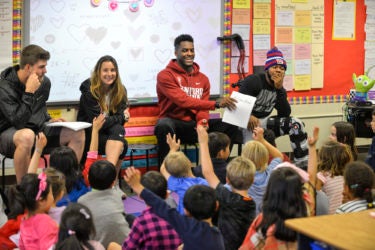
Image credit: Rod Searcey
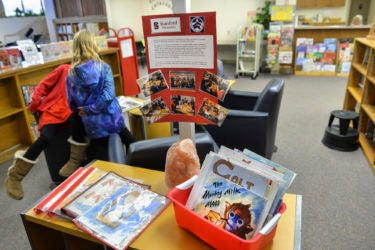
Image credit: Rod Searcey
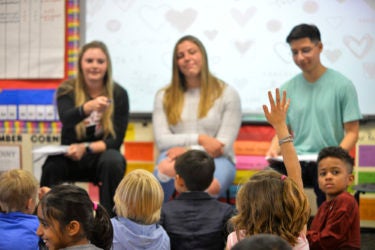
Image credit: Rod Searcey
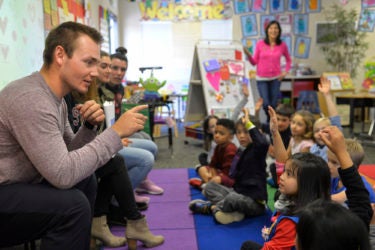
Image credit: Rod Searcey
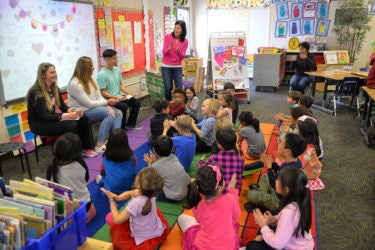
Image credit: Rod Searcey
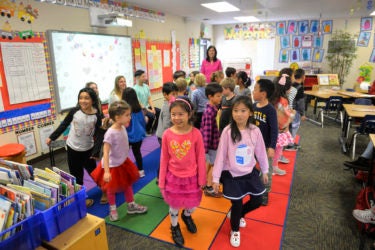
Image credit: Rod Searcey
In the process, students learn how to craft media-rich projects that are original, entertaining, educational and thought-provoking.
All these skills transfer to the corporate world, where presentations are crucial and the audience attention span no less short.
“Students sometimes sign up for the class because they think it’s a fun, escapist project,” said instructor Erik Ellis, an advanced lecturer in Stanford’s Program in Writing and Rhetoric who has taught the course since 2012. “And it is fun, but they learn how hard it is. You have to be so concise. You have to convey meaning in 32 pages in a way that captivates the kids. Do the page-turns work? Do the jokes work? How intensely should conflict be represented?
“Hundreds of decisions, all made collaboratively, go into a successful project.”
The course, PWR2EE: Once Upon a Cause, fulfills Stanford’s sophomore Program in Writing and Rhetoric requirement.
Student Ramya Balasingam called the rewards emotional as well as academic.
“Some of my fondest memories as a child are of being curled alongside my parents and brothers, reading picture books,” said Balasingam, a materials science and engineering and electrical engineering student who took the course last year. “Creating picture books as a college student is a fantastic way not only to relive some of those fond memories, but also to think more deeply about the stereotypes the books often propagate.”
Transmitting past attitudes
Through research and essay-writing, Ellis’ students see how picture books influence their readers and, through them, their eras. Classic children’s books are read and recommended for generations, Ellis said, longer than many other forms of popular culture. More than other media children may encounter, picture books transmit past generations’ attitudes about gender, race and social mores.
Ellis cites a 2006 study of hundreds of late 20th-century and early 21st-century children’s books, nearly two-thirds of which had male main characters. He also cites a 2017 survey, conducted by Nielsen for The Guardian newspaper, that found characters in Britain’s top 100 picture books were 73 percent more likely to be male. Females, Nielsen noted, were typically mothers, victims or prey species.
Ellis said he suspects this bias is often unconscious as authors, both in his class and in the wider world, imitate books of bygone years.
“I ask my students, ‘What would happen if this hero were female?’” he said. For the class book The Resource War, in which a young girl brings peace to her culture by ending its drought, the student pitching the idea had originally envisioned a male protagonist. “Right there on the spot,” Ellis said, “he decided to have the main character be a girl.”
Ellis’ students meet in Cubberley Education Library, where they learn what goes into a classic children’s book, view examples and find resources for their research projects. Each student pitches a story idea. The Nixon first-graders vote for the top three. Ellis’ students then break into groups of five to execute the top ideas.
On a recent afternoon, Ellis’ winter quarter students met with Nixon teacher Katherine Sullivan’s first-graders to read their rough drafts and get input from the kids. Each quarter’s students meet four times with Nixon children to develop and share the books.
‘Be confident in your feathers!’
“Today we’ll be reading to you from Bill the Bird,” class member Donald Stewart told students as he opened the rough draft of his group’s picture book.
“‘It was a beautiful day as Bill woke up for his first day of school. His father said, ‘Be confident in your feathers, Bill!’”
“‘But,’” continued classmate Dorian Maddox, “‘he was too shy to introduce himself to the other animals.’”
In the story, co-authored with Devery Hamilton, Taylor Kirkpatrick and Erik Miller, Bill, who is beautiful but can’t fly, finds the courage to reach out on the playground to Sally the Squirrel, who’s also lonely. They soon have so much fun that all the other animals want to join in.
The Stanford students learned that the first-graders, who are only just learning to read, are much more engaged when large, clear images are already part of the story.
“Children’s visual literacy is much higher than adults,’” Ellis said. “When they can’t read, or are learning to read, they pay extra-close attention to the illustrations.” While critiquing the mockup for Ripley and the Big Race, in which a young race car goes to race-car school, one Nixon first-grader pointed out that the “kid” race cars were the same size as the adult cars. The group took this insight to heart and scaled them proportionally in the final book.
Charting students’ concerns
Grants from Stanford’s Office of the Vice Provost for Undergraduate Education have funded art supplies and the printing and binding of books into glossy paperbacks. As well as going to Nixon’s library and to each participating first-grader, each book is cataloged into Cubberley’s permanent collection. They’re used by Graduate School of Education teacher-training students needing classroom material, by campus parents of small children and by Stanford students who tutor through the Haas Center for Public Service and other entities.
The student-produced books have research value as a way to chart student attitudes and concerns over time, said Kathryn Kerns, head of Cubberley Library and curator of education resources for Stanford Libraries.
“Their work reflects what’s out there,” Kerns said. “One year they were very interested in bullying and death. Another year, it was wildlife and resource conservation.”
One book has been checked out so often it had to be rebound in hardcover: Jenny Meets the Giant, a tale of San Francisco’s wild parrots of Telegraph Hill from a parrot’s point of view.